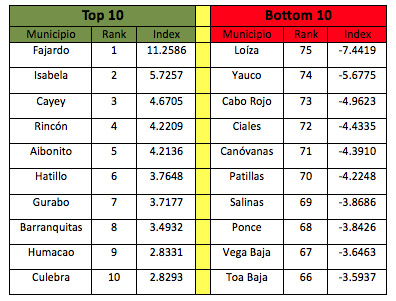Fiscal health index shows most P.R. towns carry deficits

The majority of Puerto Rico’s 78 municipalities are in dire financial conditions, with more than half carrying deficits on their general funds, the Center for Integrity in Public Policy (CIPP) revealed in its third annual Financial Health Index.
The think-tank’s study is a measurement tool developed to allow peer-to-peer comparisons among Puerto Rico’s 78 municipalities using standardized financial indicators.
The index showed that total long-term debt for all municipalities exceeded $5 billon. Since 2010, municipal debt has increased at a faster rate than that of the central government, said Arnaldo Cruz, co-founder of CIPP.
Furthermore, 37 of 75 municipalities have a negative general fund balance (end of year), 38 of 75 municipalities had a negative change on their net position, 62 of 75 municipalities have a negative unrestricted net position, and 33 of 75 municipalities receive more than 40 percent of the general fund revenues from the central government.
There were three municipalities — Villalba, Ceiba, and San Isabel — that did not provide audited financial statements in time this year, thus the ranking is based on 75 municipalities.
The findings showed that the 10 municipalities on the bottom of the index — Loíza, Yauco, Cabo Rojo, Ciales, Canóvanas, Patillas, Salinas, Ponce, Vega Baja and Toa Baja — carried an average 10 percent deficit on their general fund, with Cabo Rojo ranking the highest at a 24 percent operational deficit.
In aggregate, their net assets declined by more than $50 million, and all have a combined deficit fund balance of $86 million, even though most of these municipalities have a population of less than 50,000. The 10 towns have more than $900 million in long-term debt.
Since this year it had data dating back to 2010, the CIPP was able to analyze trends and identify municipalities that had a bad financial position in 2010 and consistently showed lack of fiscal discipline every year. Given the amount of money granted to these municipalities by the central government — $500 million a year — in some cases it appeared that mayors “don’t really have the proper incentives to improve their municipalities’ fiscal health,” think-tank executives said.
For example, the bottom 10 municipalities in the index received a total of $69 million from the central government in 2015 alone.
As far as the top 10 municipalities are concerned — Fajardo, Isabela, Cayey, Rincón, Aibonito, Hatillo, Gurabo, Barranquitas, Humacao and Culebra — several are making a repeat appearance this year. Most notable is the municipality of Fajardo, which has topped the index each year.
Since the CIPP index puts more weight on current fiscal year indicators like deficit/surplus and changes in net assets, the fact that these municipalities maintain high ranks indicates consistent restraint and good fiscal discipline.















